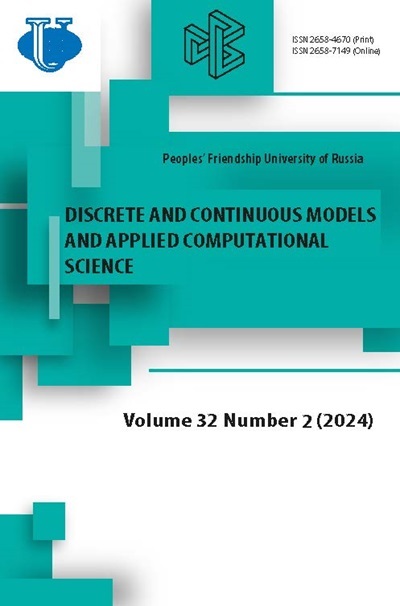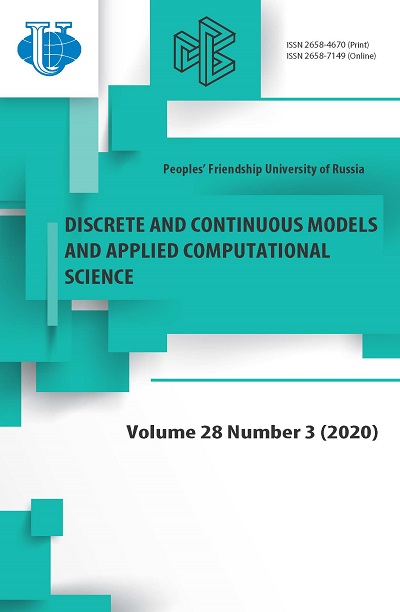О скорости сходимости одного класса марковских цепей с групповым обслуживанием требований
- Авторы: Крюкова А.Л.1
-
Учреждения:
- Вологодский государственный университет
- Выпуск: Том 28, № 3 (2020)
- Страницы: 205-215
- Раздел: Статьи
- URL: https://journals.rudn.ru/miph/article/view/24702
- DOI: https://doi.org/10.22363/2658-4670-2020-28-3-205-215
Цитировать
Полный текст
Аннотация
Существует множество систем массового обслуживания, которые принимают единичные требования, накапливают их и обслуживают только как группу. Примеры таких систем можно найти в различных областях человеческой жизни от трафика транспортных перевозок до обработки запросов в компьютерных сетях. Этим обуславливается актуальность нашего исследования. В этой статье изучается некоторый класс конечных марковских моделей массового обслуживания с одиночным прибытием и групповым обслуживанием. Рассмотрена прямая система Колмогорова для соответствующего класса цепей Маркова. Метод определения границ сходимости, основанный на понятии логарифмической нормы, здесь не применим. Такой подход даёт точные оценки для моделей, для которых матрица соответствующей системы существенно неотрицательна, но в нашем случае это не так. Здесь мы использовали новый метод «дифференциальных неравенств» для получение оценки скорости сходимости для этого класса конечных марковских моделей. Кроме того, мы получили оценки скорости сходимости и вычислили предельные характеристики и для соответствующей нестационарной модели. Заметим, что результаты могут быть успешно применены для моделирования сложных биологических систем, в которых возможны рождения новых особей только по одной и гибель групп.
Полный текст
- Srinivasan et al., “
Об авторах
А. Л. Крюкова
Вологодский государственный университет
Автор, ответственный за переписку.
Email: kryukovaforstudents@gmail.com
Lecturer of Department of Applied Mathematics
ул. Ленина, д. 15, Вологда, 160000, РоссияСписок литературы
- R. Nelson, D. Towsley, and A. N. Tantawi, “Performance analysis of parallel processing systems,” IEEE Transactions on Software Engineering, vol. 14, no. 4, pp. 532–540, 1988. doi: 10.1109/32.4676.
- J. Li and L. Zhang, “MX /M /c Queue with catastrophes and statedependent control at idle time,” Frontiers of Mathematics in China, vol. 12, no. 6, pp. 1427–1439, 2017. doi: 10.1007/s11464-017-0674-8.
- A. Zeifman, R. Razumchik, Y. Satin, K. Kiseleva, A. Korotysheva, and V. Korolev, “Bounds on the rate of convergence for one class of inhomogeneous Markovian queueing models with possible batch arrivals and services,” International Journal of Applied Mathematics and Computer Science, vol. 28, pp. 141–154, 2018. doi: 10.2478/amcs-2018-0011.
- A. Zeifman, A. Sipin, V. Korolev, G. Shilova, K. Kiseleva, A. Korotysheva, and Y. Satin, “On Sharp Bounds on the Rate of Convergence for Finite Continuous-time Markovian Queueing Models,” in Computer Aided Systems Theory — EUROCAST 2017. EUROCAST 2017. Lecture Notes in Computer Science, R. Moreno-Díaz, F. Pichler, and A. Quesada-Arencibia, Eds., vol. 10672, 2018, pp. 20–28. doi: 10.1007/978-3-319-74727-9_3.
- A. Zeifman, Y. Satin, A. Kryukova, R. Razumchik, K. Kiseleva, and G. Shilova, “On the Three Methods for Bounding the Rate of Convergence for some Continuous-time Markov Chains,” International Journal of Applied Mathematics and Computer Science, vol. 30, pp. 251–266, 2020. doi: 10.34768/amcs-2020-0020.
- Y. Satin, A. Zeifman, and A. Kryukova, “On the Rate of Convergence and Limiting Characteristics for a Nonstationary Queueing Model,” Mathematics, vol. 7, no. 678, pp. 1–11, 2019. doi: 10.3390/math7080678.
- B. Almasi, J. Roszik, and J. Sztrik, “Homogeneous finite-source retrial queues with server subject to breakdowns and repairs,” Mathematical and Computer Modelling, vol. 42, no. 5, pp. 673–682, 2005. DOI: 10. 1016/j.mcm.2004.02.046.
- A. Brugno, C. D’Apice, A. Dudin, and R. Manzo, “Analysis of an MAP /PH/1 queue with flexible group service,” International Journal of Applied Mathematics and Computer Science, vol. 27, no. 1, pp. 119–131, 2017. doi: 10.1515/amcs-2017-0009.
- A. Di Crescenzo, V. Giorno, B. K. Kumar, and A. Nobile, “A Time-Non-Homogeneous Double-Ended Queue with Failures and Repairs and Its Continuous Approximation,” Mathematics, vol. 6, no. 5, p. 81, 2018. doi: 10.3390/math6050081.
- A. N. V. Giorno and S. Spina, “On some time non-homogeneous queueing systems with catastrophes,” Applied Mathematics and Computation, vol. 245, pp. 220–234, 2014. doi: 10.1016/j.amc.2014.07.076.
- B. Granovsky and A. Zeifman, “Nonstationary Queues: Estimation of the Rate of Convergence,” Queueing Systems, vol. 46, pp. 363–388, 2004. doi: 10.1023/B:QUES.0000027991.19758.b4.
- H. LI, Q. Zhao, and Z. Yang, “Reliability Modeling of Fault Tolerant Control Systems,” International Journal of Applied Mathematics and Computer Science, vol. 17, no. 4, pp. 491–504, 2007. doi: 10.2478/v10006-007-0041-0.
- A. Moiseev and A. Nazarov, “Queueing network MAP − (GI/∞)K with high-rate arrivals,” European Journal of Operational Research, vol. 254, no. 1, pp. 161–168, 2016. doi: 10.1016/j.ejor.2016.04.011.
- J. Schwarz, G. Selinka, and R. Stolletz, “Performance analysis of time-dependent queueing systems: Survey and classification,” Omega, vol. 63, pp. 170–189, 2016. doi: 10.1016/j.omega.2015.10.013.
- N. Vvedenskaya, A. Logachov, Y. Suhov, and A. Yambartsev, “A Local Large Deviation Principle for Inhomogeneous Birth-Death Processes,” Problems of Information Transmission, vol. 54, no. 3, pp. 263–280, 2018. doi: 10.1134/S0032946018030067.
- A. Zeifman, S. Leorato, E. Orsingher, Y. Satin, and G. Shilova, “Some universal limits for nonhomogeneous birth and death processes,” Queueing Systems, vol. 52, no. 2, pp. 139–151, 2006. doi: 10.1007/s11134-006-4353-9.
- A. Zeifman, V. Korolev, Y. Satin, A. Korotysheva, and V. Bening, “Perturbation Bounds and Truncations for a Class of Markovian Queues,” Queueing Systems, vol. 76, no. 2, pp. 205–221, 2014. doi: 10.1007/s11134-013-9388-0.
















